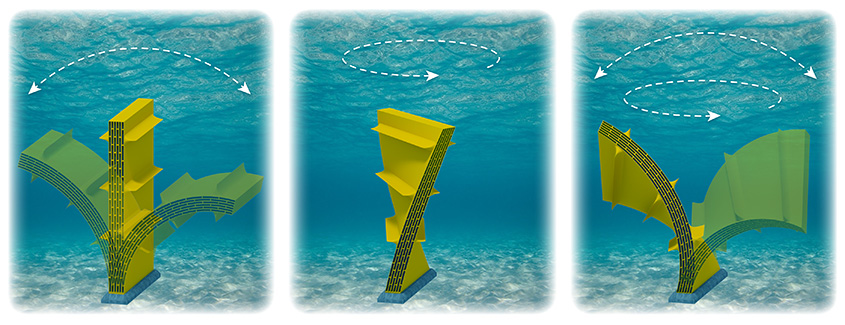
Scientists with the National Renewable Energy Laboratory have received a patent for a fledgling technology domain – distributed embedded energy converter technologies, or DEEC-Tec – that will be applied for marine energy converters.
The invention’s first patent is for applications in marine renewable energy from ocean and river waves, currents and tides. But DEEC-Tec (pronounced deck-tech) could eventually transform sources of everyday energy, including almost all physical motions or dynamic shape changes, into electricity or other forms of usable energy.
Imagine clothing that charges your smart watch as you walk, buildings that vibrate in the wind and power your lights and a road that extracts energy from the friction created by moving cars.
“The DEEC-Tec domain has legs and is growing,” said Blake Boren, a senior engineer at NREL and lead inventor on the patent, along with Jochem Weber, chief engineer for NREL’s water power program. “The patent shows that we’re gaining momentum in a fruitful area of research.”
How does this DEEC-Tec domain work? Individual energy converters work together, like muscle cells, to create a larger structure. Most devices use one generator to convert ocean energy into clean and renewable sources of energy, including electricity. But DEEC-Tec amasses its many tiny converters to form one larger, often flexible energy converter. Combined, these tiny converters can form the foundation of fabrics, bulkheads, support structures and more. For example, DEEC-Tec-based wave energy converters could look like balloons that contract and expand, snakes that undulate, or paddles that twist and bend.
Flexible wave energy converters, also known as flexWECs, can harness and convert waves into usable energy throughout their entire structure. So, no matter where or how wave energy interacts with a device’s structure, energy converters will be there to transform that wave into power.
Because flexWECs do not concentrate ocean wave energy into a singular energy converter (like a lone rotary generator or hydraulic piston cylinder) or one power transmission system (like a drive shaft or gearbox), they avoid accumulating ocean wave forces that could potentially shut off or damage the machine. Unlike other wave energy converters that use large steel frames to protect their rigid bodies from oceanic forces, flexWECs can go with the flow. FlexWECs’ frames could also enable them to harness energy from a wider range of ocean locations and wave energy frequencies, NREL said.
“One day, there could be DEEC-Tec-based marine renewable energy farms off the coast of California, Oregon, or Washington, with these types of wave energy converters potentially powering coastal communities or the utility grid at large,” Boren said.
High costs are one of the last major hurdles the marine energy industry must overcome. Because flexWECs host far more than one energy converter, they could require fewer maintenance trips. If only a small group of tiny converters requires fixing, all others could continue operating.
FlexWECs can also be built with more sustainable, cost-effective materials, making them easier to install and control once out in the ocean. Greater control could mean increased energy production, NREL said.
Because the DEEC-Tec domain is relatively new, Boren and his team are working to explore exactly how these technologies could create a new generation of marine energy devices or other energy generating materials.
NREL is a national laboratory of the U.S. Department of Energy, Office of Energy Efficiency and Renewable Energy, operated by the Alliance for Sustainable Energy LLC.